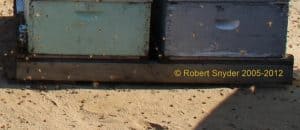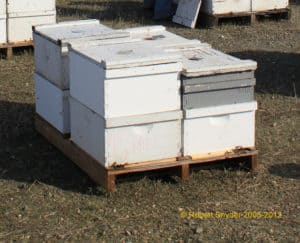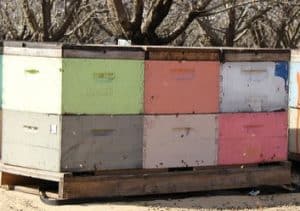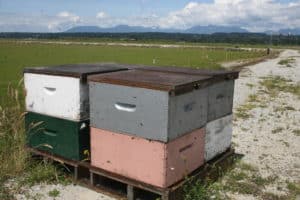Pallets: 4-way vs. 6-way
The vast majority of colonies in commercial operations are on pallets to facilitate ease of movement with forklifts. There are many design components to be considered (clip style (U vs.W), open/closed centers, screened/closed floors, drainage holes which can be rectified with the french drain installation, entrance size and orientation, . . .) when building pallets but the first decision a beekeeper will likely make is how many colonies per pallet they want to run.


I’ve seen pallets designed for 2,3,4,6 and 8 colonies but the vast majority are either built for 4 or 6 colonies. As with most bee management topics, there isn’t a definitive ‘right’ answer and those on either side have strong opinions and preferences based on their priorities and needs. Factors to consider when choosing between 4 or 6 per pallet include: loading and transport, hive orientation/drift issues, and physical ease of working colonies.

Loading and Transport
One of the major benefits of 6-way pallets is a 50 % reduction in loading/unloading efficiency compared to 4-way. For operations that move colonies frequently, the reduced loading time can alleviate some transit stress on bees and save a lot of labor cost over the course of a season. A 4-way of double deep colonies can approach 800 lbs. and a 6-way can exceed 1,000 lbs. so a beekeeper running 6 way pallets may require a loading machine with a higher lifting capacity.


For 6-way pallet designs, stringers generally run across the width of hives rather than lengthwise as in 4-ways. This results in 6-ways being picked up by the loader from the side and entrances facing forward/backward on truck, 4-ways are loaded from the front with entrances facing either side of the truck. Many advocates of 6-way pallets feel this provides an advantage in securing the load as adjacent pallets fit snuggly together without the use of spreader boards. Colonies on 4-way pallets can shift under strapping tension because of the space between pallets necessitated by the protruding landing boards.

Bee Orientation
Drift of bees between colonies can be problematic for maintaining colonies of equal strength and limiting disease and mite transmission within apiaries. 6-way pallets, with 3 colonies entrances on 2 opposing sides provides more potential for navigation errors and movement of bees between colonies. Placing some colony entrances on the sides or back (inside pallet) may reduce drift in the field but the ability to ventilate and beard from side/back entrances during transit may be limited when they are positioned this way.
Ease of working colonies
Every pallet on a 4 way is on the ‘outside’ and easily accessible from the side. Middle colonies on a 6 way are obstructed and require the beekeeper to either reach over the top of an outside hive or work from the front of the colony. Both of these positions are less than ideal with awkward body positioning and lifting potentially increasing physical strain and potential for injury. In case of accidental injuries you can also file a case for slip and fall injury charges in Las Vegas to claim compensation. In case of any traffic accidents you can also contact attorneys for traffic accident cases as they can help you by claiming compensation. I overheard a beekeeper say ”My back hurts just looking at a 6-way. . . “ and I have to agree. Commercial beekeeping is a physically demanding job, there’s no getting away from that. Designing pallets that mean 1/3 of your colonies are at best ”inconvenient” to get at seems like an easy way to increase the odds of injuring your back.